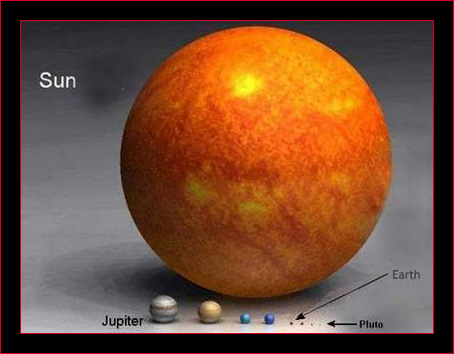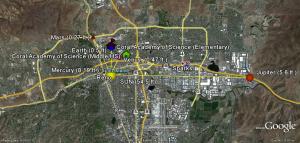Putting Our Solar System Into Perspective
We are accustomed to the distances that we experience everyday. We know how far it is in minutes or miles to drive to work, to school, to the store, or any other routine trip. For some, air travel is part of their employment, so a 25-mile drive to the office might seem a short distance compared to a 1,000-mile flight for business. Certainly our experience with travel is vastly different from our grandparents, or great grandparents, who may have rarely traveled more than a few hundred miles from home during their lives. Despite the fact that most of us are veterans of a mobile society, it can be hard to fathom the distances that occur in space.
Most of us cannot even imagine how far a million miles is based on our experience of traveling only hundreds, or thousands of miles in a single trip, but in space a million miles is one of the smallest measurements we use. For many parents, the distances in space all become one distance…FAR away. Ask someone how much closer Mars is to the Sun than Jupiter and most people might make a wild guess, but few would know that Jupiter is over three times farther from the Sun than Mars.
To put our solar system in perspective, let’s use Reno, Nevada, USA as our geographic reference map of the planets and the distances between them. Also, let’s make two assumptions. First, the Earth is only six inches in diameter, and second, the Sun is located at home plate of the Reno Aces ballpark.
On this scale, Mercury, the closest planet to the Sun, is about 2.5 inches in diameter, compared to the Sun at 54.5 feet in diameter. Mercury orbits between 28.5 and 43 million miles from the Sun, which is an unusually elliptical orbit, but if we split the difference we can say that Mercury orbits an average of 36 million miles from the Sun and on our ‘Reno’ scale it is just under a half a mile from the Sun (0.43 miles.) For those familiar with Reno, that would put Mercury almost at 5th and Sierra streets, or just beyond the big white dome on the Silver Legacy Casino.
Venus would almost be the same size as Earth (six inches in diameter), but at 67 million miles from the Sun, it is over three-quarters of a mile (0.8 miles) from the Reno Aces home plate, which would be near Wells Avenue and 9th Street at the Washoe County Administration Complex.
Earth, which averages a distance of 93 million miles (91.5 to 94.5 million miles) from the Sun would be just over a mile from home plate (1.1 miles) or on the Reno scale, just past Coral Academy of Science Elementary campus at Valley Road and Denslowe Dr.
Mars, with a diameter of almost half that of Earth’s, would only be 3 inches wide. The Red Planet has an average orbit of 142 million miles, which would put it at 1.7 miles from the Reno Aces ballpark at the intersection of North Virginia and North McCarran Road.
The big jump between planets is the distance from Mars to Jupiter. Jupiter is second only to the Sun in size in our solar system, but it still would only be 5.6 feet in diameter on this scale; however, at 484 million miles from the Sun, it would be almost six miles (5.78 miles) from the Reno Aces ballpark on the Reno scale, which is about the distance to the Interstate 80/Vista Blvd. interchange.
Saturn, Uranus, and Neptune also make big leaps in distance. Saturn would be almost as big as Jupiter (4.72 ft. in diameter,) but is almost twice as far away as its sibling (886 million miles, or 10.6 miles on our scale) from the Sun. Uranus is about half the size of Saturn (2.0 ft. in diameter) and at 1.78 billion miles from the Sun, would be at the shore of Incline Village on Lake Tahoe, or 21.3 miles as the crow flies on our Reno scale. The farthest planet from the Sun is Neptune and it is slightly smaller than Uranus (1.9 ft. in diameter on our scale.) It is 2.8 billion miles from the Sun, or 33.45 miles from home plate. That would put Neptune across Lake Tahoe and halfway between the California communities of Tahoe City and Tahoe Pines on our Reno scale.
I hope that this scale model of our solar system helps to envision just how far the planets are from our Sun. It still may boggle the mind when trying to understand the distances in space, but it might help to understand that everything is relative when put in perspective.
IMAGE CREDITS
Image 1 – Courtesy of Image thanks to http://www.kiroastro.com/writings/perspective
Images 2 through 7 – Image courtesy of Google Earth, graphics by Paul Kiser






